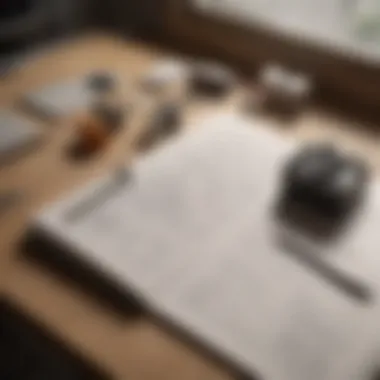Calculating Your Home's Square Footage: A Detailed Guide


Intro
Calculating the size of your home is more than just a exercise in numbers; it paves the way for important decisions. Whether you're thinking about selling or buying, considering renovations, or simply re-evaluating your living space, understanding the concept of square footage is crucial. This guide isn't just about math. It’s a detailed roadmap that covers techniques for measuring your home, the real-world implications of those measurements, and specific considerations you may need to account for.
With a keen focus on practical applications, we will break down methods for calculating square footage accurately. We'll explore how different architectural styles and design elements can affect those calculations. For anyone interested in the nuances of real estate or home renovation, this info is like gold. So, roll up your sleeves as we get ready to navigate through the ins and outs of square footage determination.
Understanding Square Footage
Determining the square footage of your home is not just a mundane calculation; it's a gateway to various crucial decisions in the realms of real estate, renovation, and design. Picture this: you’re eyeing that dream house, or maybe you're finally considering that long-overdue home makeover. Understanding square footage can make or break your plans. Knowing the actual size of different spaces directly influences your property’s valuation, helps in estimating renovation costs, and even aids in creating a more functional living environment.
In a world where every inch counts, a clear grasp of what square footage entails can give you a competitive edge. Whether you are a first-time buyer or a seasoned investor, square footage is a key metric in evaluating property. It helps in setting realistic expectations during negotiations and ensures that whether you're buying or selling, both parties are on the same page regarding the space in question.
Definition of Square Footage
Square footage, quite simply, is the measurement of a space expressed in square feet. This figure is derived by multiplying the length and width of a space. For instance, if you have a room that measures 10 feet by 12 feet, the total square footage is 120 square feet (10 x 12 = 120). However, it ain’t always that straightforward.
Many homes have irregular shapes or additional nooks that can complicate the calculations. In these situations, breaking the space down into smaller rectangles can yield a more accurate total. For example, if you’re measuring an L-shaped living room, you could divide it into two rectangular sections, determine their areas separately, and then add them together.
Importance of Accurate Measurements
When it comes to square footage, accuracy is key, and here’s why:
- Investment Decisions: Wrong measurements can lead to poor investment choices. Imagine purchasing a property thinking it has 2,000 square feet when it only has 1,800. That 200 square feet can mean a lot in terms of value.
- Renovation and Furnishing: If you're planning to renovate or buy new furniture, having precise measurements helps ensure that your designs fit perfectly. A sofa that's too large for your space can throw a wrench in your entire decor plan.
- Property Assessments: Real estate agents rely heavily on accurate square footage for appraisals, which ultimately affects market value. The bigger your home, generally speaking, the higher its worth, so getting it wrong can cut into your profits when selling.
Accurate measurements aren’t just numbers; they’re the foundation of informed decisions in real estate.
Whether it’s calculating the square footage for your living room, backyard, or basement, every detail counts in this calculation. Keeping these things in mind will streamline your processes and many times save you from costly miscalculations.
Preparing for Measurement
Before you dive headfirst into measuring the square footage of your home, it’s vital to understand how crucial the preparation phase is. A well-thought-out approach can save you from headaches down the line. Whether you’re planning to sell your house, make renovations, or simply understand its layout better, a foundational grasp of how to prepare can lead to more accurate results.
Essential Tools Needed
To begin with, having the right tools can make all the difference. Here are some key instruments that will serve you well in your measurement endeavors:
- Tape Measure: A sturdy tape measure is essential, preferably one that extends at least 25 feet. Consider a locking mechanism for ease.
- Laser Measuring Device: If you really want to take your measuring game up a notch, these gadgets can save you time and provide a quick estimate.
- Notebook and Pen: Documenting your measurements is crucial. A simple notebook allows you to keep track of various areas without misplacing numbers.
- Calculator: Whether it's a physical calculator or an app on your phone, this will help you double-check your math calculations.
- Graph Paper: Handy for sketching out floor plans. You might not need it, but it can offer clarity if your home has an unusual layout or number of rooms.
"Being prepared means knowing what you need before you even start measuring."
Creating a Measurement Plan
After you gathered the tools, the next step involves crafting a concrete measurement plan. This plan should lay out how you’ll approach the task of measuring each section of your home. Consider the following:
- Divide Your Home Into Sections: Group your measurements by rooms and external areas. For instance, you might handle all the bedrooms at once and then move on to communal areas like the living room.
- Prioritize Layout: If your home has open spaces, treat them as a single unit while measuring. Likewise, for complex angled rooms, ensure you have a method to calculate them accurately.
- Include All Areas: Don’t forget those hidden spots! Attics and basements often get overlooked but contribute to your home's total area.
- Consider Future Use: Think about what you’ll need the measurements for. If you plan to renovate, note the specific areas you’ll focus on more intensely later.
This strategy not only streamlines your approach but helps ensure you don’t miss any crucial metrics. A thoughtful plan allows you to navigate your space methodically, making the measuring task less daunting and more manageable.
Measuring Square Footage of Different Areas
Determining the square footage of your home goes beyond just knowing numbers. Each part of your house contributes to its overall value and functionality, making it essential to measure various areas accurately. This section will navigate through how to measure the square footage of different spaces inside and outside your home. Understanding these nuances is key, especially for those considering renovation projects or real estate assessments.
Measuring Rooms
Rooms often serve specific functions within a house. Accurately measuring them helps home buyers visualize living spaces better, and gives homeowners a clearer picture of where enhancements might be beneficial. Each room has its own character and layout, demanding tailored measurement techniques. That said, here’s how to tackle measuring some common rooms:


Living Room
The living room is typically the heart of a home—where people gather, memories are made, and furniture comes together. Measuring this space can sometimes be a tad tricky due to its shape or arrangement of furniture. It's crucial to get both the length and width, so you can multiply them for the area. Consider any built-in shelves or nooks while measuring, as they can consume valuable space. One unique aspect is the ceiling height; if it��’s vaulted, that might give a different flair but doesn't add to square footage, especially if appraising for resale.
Dining Room
When it comes to the dining room, it's often considered a formal space. Here too, measuring involves understanding how length and width interplay with your table and chairs. Think about pathways as well; you'll want to ensure they're not too cramped. The presence of a large dining table can also affect the flow and usability, which may play into future renovation plans, reflecting the importance of accurate measurements.
Bedrooms
Bedrooms come with their own rhythm and requirements. For measuring, making sure you account for closets and any other recesses is vital. Dimensions here can affect not just aesthetics but also space for important pieces like furniture and storage solutions. Different layouts, like a master suite with an en-suite bathroom, add another wrinkle to your measuring efforts. Remember, it’s about functionality as well as size—no one wants to squeeze between a bed and the wall in the morning rush.
Bathrooms
In bathrooms, things can get a bit peculiar. Not only do you need to measure the floor area, but the space often holds fixtures like sinks, tubs, and toilets that take up valuable room. It's essential to verify clearance and spacing around these fixtures. Having an idea of usable space versus occupied area can vastly influence renovation decisions, especially among those aiming for a serene bathroom environment.
Measuring External Spaces
External spaces play an equally crucial role in determining square footage. They can amplify your home's living area or potentially complicate a sale if not accurately accounted for. Here’s how to measure common external spaces:
Patios and Decks
Patios and decks can really extend your living area outdoors. Measuring them generally requires knowing the dimensions just like an indoor space, but don't forget to note the materials used. Some may want to include all outdoor assets in assessments, especially if they’ve added value. A downside could be weather conditions potentially limiting access or influencing the usability of these areas.
Garages and Sheds
Garages and sheds are often seen as a utility space, but properly measuring them helps show their true contribution to the property. These spaces can optimize usability and storage, reducing clutter within the home. However, clutter or an unkempt garage might overshadow the advantages if the measurements don't account for disorganized areas.
Yards and Gardens
When it comes to yards and gardens, size matters often—our green patches are a hot topic. Buyers appreciate greenery, but the way these areas are measured can differ. Some homeowners prefer the square footage to feature a landscaped garden, while others prefer to show their yard's full expanse. Unique features, like pathways or retaining walls, should also be included in measurements. Prospective buyers need to know precisely how much land they may need to care for or modify.
Complex Layouts
Square footage takes on a different aspect when dealing with complex layouts including open concepts or multi-level homes. Here’s how to approach these:
Open Concept Spaces
Open concept spaces provide a refreshing feel, but they can also confuse measurements. The lack of walls makes for a dynamic living area, but each segment still needs proper calculation. Measuring from walls or using furniture placement can create a better overview of space. One challenge is discerning whether to think of these areas as individual rooms or a collective whole, impacting both calculation and design.
Multi-Level Homes
With multi-level homes, the complexity increases a notch. Each floor should be calculated separately, as well as any hallways and staircases. This means understanding the footprint of each level while being mindful of vertical space. If you're considering sellng, being precise here can ensure your listing reflects full value.
Nooks and Alcoves
Nooks and alcoves can be a charming addition, but they often get overlooked during square footage calculations. Those small spaces may provide cozy corners or essential organization areas, so measuring them accurately is paramount. While they can enhance a home’s character, they can also complicate the overall measurement process depending on their dimensions and use.
Accurate measurement of various areas is crucial for understanding your home's total value and aiding in sound renovation decisions.
Calculating Total Square Footage
Understanding how to calculate total square footage is crucial for any homeowner. Not only does it affect property valuations and buying decisions, but it also plays a pivotal role when planning renovations or upgrades. Knowing your exact square footage can guide decisions about furniture, renovations, and even impacts local property taxes. When all is said and done, accurate measurements can save you time, money, and frustration.
Using the Multiplication Method


When it comes to calculating square footage, the multiplication method is a straightforward approach that often yields the best results. This method is typically suitable for rectangular or square rooms, making it quite handy for most of your living space. To do it right, you multiply the length of the room by its width. For instance, if you have a 15-foot long living room and a width of 10 feet, you'll do the math as follows:
[ 15 \text ft \times 10 \text ft = 150 \text sq ft ]
This calculation reveals that the living room encompasses 150 square feet. It’s quick and efficient. Just be sure to measure from wall to wall and include any built-in elements such as bookshelves or cabinetry that might reduce usable space.
Adding Up Individual Measurements
Square footage can also be calculated by aggregating measurements from multiple areas within a home. This often comes into play when addressing homes with non-rectangular spaces or various room shapes. Here, each room's area can be individually measured using the multiplication method or any other technique suitable for that area, and then added together for a total. For example:
- Living Room: 150 sq ft
- Dining Room: 120 sq ft
- Master Bedroom: 200 sq ft
- Guest Room: 110 sq ft
Thus, the total square footage for these measurements would be:
[ 150 + 120 + 200 + 110 = 580 \text sq ft ]
Taking time to accurately add these measurements ensures you don’t overlook any area and helps in creating a more precise overall picture of your home’s livable space.
Considering Irregular Shapes
In many homes, you may encounter areas that defy standard shapes, making calculations a bit trickier. For such spaces, breaking down the area into smaller, more manageable sections can provide clarity. Often, using geometric shapes such as triangles or trapezoids can simplify the process. For example, if you have an L-shaped room, you can break it into two rectangles, find the square footage of each, and then combine those totals.
- Rectangle 1: 10 ft by 15 ft
- Rectangle 2: 5 ft by 10 ft
Calculating square footage would go as follows:
- Rectangle 1: 10 ft * 15 ft = 150 sq ft
- Rectangle 2: 5 ft * 10 ft = 50 sq ft
- Total = 150 + 50 = 200 sq ft
This method provides a comprehensive approach to ensure accuracy for all room shapes, leaving no stone unturned.
"The finer details in calculations may just mean richer returns on investments down the line."
By keeping these methods in mind, calculating the total square footage of your home can be a more systematic, less daunting task. Each strategy—from the multiplication method to breaking down irregular shapes—gives a clear way to tackle the challenge and gain an accurate understanding of your domicile.
Special Considerations
When you're measuring the square footage of your home, it’s not just about measuring every room. There are nuances and special considerations that can significantly affect your final numbers. Understanding these details can help you make informed decisions, whether you are designing your living space or evaluating a property’s real estate worth. Certain elements can alter measurable space and, consequently, your calculations need to reflect that reality.
Factors Affecting Measurements
Measuring square footage isn’t simply a matter of mapping out length and width; various factors can complicate this process.
Built-In Furniture
When it comes to built-in furniture, these installations often prove both practical and stylish. The value of built-in pieces like bookcases or window seats lies in their ability to maximize existing space. However, they can also skew measurements if not considered correctly during your calculations.
For example, if you include the depth of a built-in cabinet in a room’s total square footage, you might end up overestimating the area. It's vital to measure around these structures carefully and accurately define the usable space they offer versus what they occupy.
Some advantages of built-in furniture include:
- Efficiency: They often utilize odd spaces that would otherwise go unused.
- Aesthetics: They can enhance a room’s design with a custom touch.
Architectural Features
Architectural features can add charm and character to any home. From intricate moldings to fireplace surrounds, these elements often reflect the unique identity of a space. However, just like built-ins, they can have varying effects on your square footage calculations.
Recognizing how these features interact with measurements is crucial. For instance, a large arched doorway might look visually intriguing, but it also takes up some room that needs to be accounted for.


When documenting square footage, you might face challenges such as:
- Inaccessible Areas: Some features might create space that isn't easily accessible or usable, impacting utility.
- Complicated Shapes: Intricate details might complicate your measuring process and cause potential inaccuracies if overlooked.
Skylights and Vaulted Ceilings
On the other hand, skylights and vaulted ceilings can make a space feel expansive and airy. They increase the sense of volume in a room but don’t necessarily add square footage in the traditional sense. Quite the opposite, these features can sometimes reduce functional living areas, making it essential to balance aesthetics with practical measurements.
One key characteristic to keep in mind: while skylights brighten a room, they don't contribute to the overall floor area, which can be a crucial distinction in certain calculations.
Additionally, consider these points regarding skylights and vaulted ceilings:
- Heat Loss: If not well-insulated, they can lead to increased energy costs.
- Maintenance: Skylights might need regular cleaning and upkeep to keep them functional, which doesn’t impact square footage directly, but does affect overall home care.
Understanding these special considerations can provide clarity when undertaking square footage calculations. They remind us that each element of design holds not just visual appeal but also implications for measurement accuracy. As we delve deeper into local regulations and property value, these factors become increasingly crucial.
Tools for Calculating Square Footage
Calculating the square footage of a home isn’t just a casual afternoon task; it's a necessity for homeowners, real estate agents, and anyone looking to renovate. The right tools can make all the difference, turning a daunting chore into a straightforward endeavor. Having the right resources at your fingertips not only streamlines the process but also enhances precision, which can have significant implications in everything from property valuation to design decisions.
When one steps into this realm, whether for buying, selling, or remodeling, knowing which tools to wield provides a measure of confidence. Accurate measurements lay the groundwork for smart decisions, whether it’s negotiating prices or planning layouts. Let’s dig into digital and manual tools that can help you measure your space effectively.
Digital Measurement Tools
In our tech-savvy world, digital tools have carved out a comfortable niche in measuring square footage. These devices and apps can offer precision that goes beyond traditional methods, helping you see the numbers clearly and quickly.
- Laser Distance Measurer: This nifty gadget is a favorite among contractors and homeowners alike. It works by emitting a laser beam to measure distances with exceptional accuracy. It's particularly useful for larger spaces where tape measures become unwieldy. Plus, many modern models store multiple measurements, letting you keep track with ease.
- Measurement Apps: With smartphones glued to our palms, several apps have surfaced, turning your device into a powerful measuring tool. Apps like MagicPlan can even create floor plans and help you calculate square footage on the fly. Some of these tools allow sharing plans with contractors effortlessly, making collaboration a breeze.
- Smart Scales and Floor Plan Generators: If you want to go a step further, consider advanced solutions like smart scales that generate detailed floor plans. They require an upfront investment, yet they pay off with their robust features that cater to both amateur and professional needs.
Digital technology offers speed and precision that can save you a boatload of time. But remember, like any tech, it’s always good to double-check discrepancies with manual techniques for peace of mind.
Manual Calculation Techniques
While the digital realm offers remarkable advancements, there’s an undeniable charm and reliability associated with manual measuring techniques. These methods often engage you more directly with your space and can be invaluable when technology fails or is unavailable.
- Tape Measures: The good old tape measure might seem basic, but it’s a tried-and-true method. Keeping a sturdy 25-foot tape at hand gives you flexibility. Remember to measure the width and length of each room separately, writing them down as you go.
- Graph Paper: Once you've got your measurements, sketching out the layout on graph paper can provide a visual reference, helping to avoid oversights. Each square can represent a specific unit of measure, helping you visualize dimensions and square footage quite effectively.
- The Pythagorean Theorem: When faced with odd shapes or angles, employing the Pythagorean theorem can help calculate the area efficiently. By breaking down the space into right angles, you can navigate complex layouts without much fuss.
Using manual methods can also draw you closer to understanding the architecture of your home. It cultivates a sense of awareness about the space you occupy, allowing you to spot things that might often go unnoticed amid the hustle and bustle of daily life.
"The most accurate measurement isn't merely about the numbers; it’s also about knowing your space intimately."
Securing your square footage accurately is critical, and utilizing both digital measurement tools and manual techniques can ensure you navigate this process with confidence and ease.
Finale
In the realm of homeownership or real estate investment, understanding how to accurately measure the square footage of a property can’t be overstated. Throughout this guide, we’ve touched upon various methods and nuances tied to calculating square footage, making it clear that a precise measurement is foundational.
Whether you’re looking to sell, buy, or renovate, having an accurate assessment of square footage opens doors to well-informed decisions. It’s not simply about numbers; it’s about grasping the value and the potential of each space. For example, knowing whether that extra nook in your living room qualifies as additional square footage can significantly impact its market price.
"Knowledge is power. Understanding your square footage empowers you to make smarter property decisions."
As one reflects on the importance of this knowledge, it's also essential to consider real estate implications. Listings often underplay or exaggerate square footage, swaying buyers’ perceptions. Additionally, proper understanding contributes to setting appropriate renovation budgets, ensuring that every square foot serves its purpose.
Key Takeaways
- Accurate Measurements Matter: Getting square footage right affects both valuation and functionality.
- Different Areas Require Different Methods: From complex layouts to simple rooms, adaptation in approach is key.
- Local Factors Influence Value: Understanding local regulations and general market standards can impact decisions.
- Tools and Techniques Are Available: Embracing both digital and manual tools enhances the measurement process, ensuring accuracy.
- Consider Special Features: Elements like built-in furniture or architectural details can affect the total square footage calculation.
Next Steps for Homeowners
- Implement Your Knowledge: Take the initial step by measuring your own home accurately to see how it stands against current market values.
- Gather the Right Tools: Equip yourself with measuring tools from tape measures to digital apps. Adapt the ones that feel intuitive to use.
- Consult Professionals: Consider seeking help from appraisers or real estate agents who understand local nuances and can assist further.
- Stay Updated on Regulations: Familiarize yourself with local property regulations related to square footage; being well-informed can save you significant headaches down the road.
- Explore Renovation Opportunities: With your newfound knowledge, look for spaces within your home that can be optimized or expanded for added value.
In summary, measuring the square footage of your home isn’t just a practical exercise; it’s a strategic move that informs and influences your future decisions in real estate.















